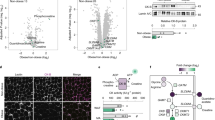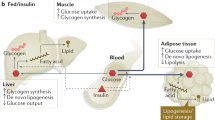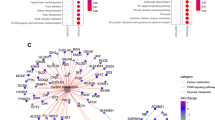Abstract
INTRODUCTION:
Obese and type 2 diabetic (T2DM) adolescents present with reduced insulin-stimulated glucose disposal and elevated intramyocellular lipids (IMCL) indicating comparable muscular insulin resistance and increased flux of free fatty acids (FFA) as in adult patients. In humans, the causal relationships between obesity and insulin resistance were examined in detail over the last years.
METHODS:
The impact of genetic factors was analyzed in young nonobese nondiabetic first-degree relatives of T2DM (REL-DM), whereas environmental factors were tested by challenging humans without genetic T2DM risk with lipid infusions or high-fat diets.
RESULTS:
REL-DM exhibit defects in mitochondrial oxidation and phosphorylation. Increased FFA availability results in accumulation of intramyocellular fatty acyl-CoA (FA-CoA) inducing a series of alterations: (i) inhibition of insulin signaling, (ii) reduction of insulin-(in)dependent glucose transport/phosphorylation, (iii) decreased insulin-stimulated glycogen synthesis, (iv) impaired insulin-stimulated oxidative phosphorylation (ATP synthesis), (v) accumulation of ectopic triglycerides (IMCL), (vi) reduced expression of peroxisome proliferator activated receptor γ (PPARγ) coactivator-1 (PGC-1) and PGC-1-controlled genes involved in mitochondrial biogenesis and oxidative phosphorylation and possibly also (vii) initiation of inflammatory processes by activation of PKC and nuclear factor-κB and decreased expression of matrix metalloproteinases (MMPs).
CONCLUSIONS:
The abnormalities could lead to a vicious cycle in which mitochondrial dysfunction, elevation of intramycellular lipids, impaired lipid oxidation and insulin resistance amplify each other. This is similar to the adaptive changes to fasting, which prevent energy loss during excessive FFA availability. The sequence of events may start with mitochondrial dysfunction in genetic insulin resistance and with increased intramyocellular lipids in environmental insulin resistance.
This is a preview of subscription content, access via your institution
Access options
Subscribe to this journal
Receive 12 print issues and online access
$259.00 per year
only $21.58 per issue
Buy this article
- Purchase on Springer Link
- Instant access to full article PDF
Prices may be subject to local taxes which are calculated during checkout


Similar content being viewed by others
References
Duncan GE, Li SM, Zhou XH . Prevalence and trends of a metabolic syndrome phenotype among US adolescents, 1999–2000. Diabetes Care 2004; 27: 2438–2443.
Weiss R, Dziura J, Burgert TS, Tamborlane WV, Taksali SE, Yeckel CW, Allen K, Lopes M, Savoye M, Morrison J, Sherwin RS, Caprio S . Obesity and the metabolic syndrome in children and adolescents. N Engl J Med 2004; 350: 2362–2374.
Sinha R, Fisch G, Teague B, Tamborlane WV, Banyas B, Allen K, Savoye M, Rieger V, Taksali S, Barbetta G, Sherwin RS, Caprio S . Prevalence of impaired glucose tolerance among children and adolescents with marked obesity. N Engl J Med 2002; 346: 802–810.
Weiss R, Dufour S, Taksali SE, Tamborlane WV, Petersen KF, Bonadonna RC, Boselli L, Barbetta G, Allen K, Rife F, Savoye M, Dziura J, Sherwin R, Shulman GI, Caprio S . Prediabetes in obese youth: a syndrome of impaired glucose tolerance, severe insulin resistance, and altered myocellular and abdominal fat partitioning. Lancet 2003; 362: 951–957.
Krssak M, Petersen KF, Dresner A, DiPietro L, Vogel SM, Rothman DL, Roden M, Shulman GI . Intramyocellular lipid concentrations are correlated with insulin sensitivity in humans: a 1H NMR spectroscopy study. Diabetologia 1999; 42: 113–116.
Perseghin G, Scifo P, De Cobelli F, Pagliato E, Battezzati A, Arcelloni C, Vanzulli A, Testolin G, Pozza G, Del Maschio A, Luzi L . Intramyocellular triglyceride content is a determinant of in vivo insulin resistance in humans: a 1H-13C nuclear magnetic resonance spectroscopy assessment in offspring of type 2 diabetic parents. Diabetes 1999; 48: 1600–1606.
Kautzky-Willer A, Krssak M, Winzer C, Pacini G, Tura A, Serdat F, Wagner OF, Brabant G, Horn R, Stingl H, Waldhäusl W, Roden M . Increased intramyocellular lipid concentrations identify impaired glucose and energy metabolism in women with prior gestational diabetes. Diabetes 2003; 52: 244–251.
Roden M . Non-invasive studies of glycogen metabolism in human skeletal muscle using magnetic resonance spectroscopy. Curr Opin Clin Nutr Metab Care 2001; 4: 26–266.
Perseghin G, Price TB, Falk Petersen K, Roden M, Cline GW, Gerow K, Rothman DL, Shulman GI . Increased glucose transport-phosphorylation and muscle glycogen synthesis after exercise training in insulin-resistant subjects. N Engl J Med 1996; 335: 1357–1362.
Petersen KF, Dufour S, Befroy D, Garcia R, Shulman GI . Impaired mitochondrial activity in the insulin-resistant offspring of patients with type 2 diabetes. N Engl J Med 2004; 350: 664–671.
Lazar MA . How obesity causes diabetes: not a tall tale. Science 2005; 307: 373–375.
Ek J, Andersen G, Urhammer SA, Gaede PH, Drivsholm T, Borch-Johnsen K, Hansen T, Pedersen O . Mutation analysis of peroxysome proliferators-activated receptor-gamma coactivator-1 (PGC-1) and relationships of identified amino acid polymorphisms to Type II diabetes mellitus. Diabetologia 2001; 44: 2220–2226.
Roden M . How free fatty acids inhibit glucose utilization in human skeletal muscle. News Physiol Sci 2004; 19: 92–96.
Boden G . Role of fatty acids in the pathogenesis of insulin resistance and NIDDM. Diabetes 1997; 46: 3–10.
Roden M, Price TB, Perseghin G, Petersen KF, Rothman DL, Cline GW, Shulman GI . Mechanism of free fatty acid-induced insulin resistance in humans. J Clin Invest 1996; 97: 2859–2865.
Roden M, Krssak M, Stingl H, Gruber S, Hofer A, Fürnsinn C, Moser E, Waldhäusl W . Rapid impairment of skeletal muscle glucose transport/phosphorylation by free fatty acids in humans. Diabetes 1999; 48: 358–364.
Krebs M, Krssak M, Nowotny P, Weghuber D, Gruber S, Mlynarik V, Bischof M, Stingl H, Fürnsinn C, Waldhäusl W, Roden M . Free fatty acids inhibit the glucose-stimulated increase of intramuscular glucose-6-phosphate concentration in humans. J Clin Endocrinol Metab 2001; 86: 2153–2160.
Dresner A, Laurent D, Marcucci M, Griffin ME, Dufour S, Cline GW, Slezak LA, Andersen DK, Hundal RS, Rothman DL, Petersen KF, Shulman GI . Effects of free fatty acids on glucose transport and IRS-1-associated phosphatidylinositol 3-kinase activity. J Clin Invest 1999; 103: 253–259.
Boden G, Lebed B, Schatz M, Homko C, Lemieux S . Effects of acute changes of plasma free fatty acids on intramyocellular fat content and insulin resistance in healthy subjects. Diabetes 2001; 50: 1612–1617.
Brehm A, Krssak M, Schmid AI, Nowotny P, Waldhäusl W, Roden M . Increased lipid availability impairs insulin stimulated ATP synthesis im human skeletal muscle. Diabetes 2005; 54: A381.
Stump CS, Short KR, Bigelow ML, Schimke JM, Nair KS . Effect of insulin on human skeletal muscle mitochondrial ATP production, protein synthesis, and mRNA transcripts. Proc Natl Acad Sci USA 2003; 100: 7996–8001.
Belfort R, Mandarino L, Kashyap S, Wirfel K, Pratipanawatr T, Berria R, DeFronzo R, Cusi K . Dose-response effect of elevated plasma free fatty acid on insulin signaling. Diabetes 2005; 54: 1640–1648.
Itani SI, Ruderman NB, Schmieder F, Boden G . Lipid-induced insulin resistance in human muscle is associated with changes in diacylglycerol, protein kinase C, and IkappaB-alpha. Diabetes 2002; 51: 2005–2011.
Richardson DK, Kashyap S, Bajaj M, Cusi K, Mandarino SJ, Finlayson J, Defronzo RA, Jenkinson CP, Mandarino LJ . Lipid infusion decreases the expression of nuclear encoded mitochondrial genes and increases expression of extracellular matrix genes in human skeletal muscle. J Biol Chem 2005; 280: 10290–10297.
Sparks LM, Xie H, Koza RA, Mynatt R, Hulver MW, Bray GA, Smith SR . A high-fat diet coordinately downregulates genes required for mitochondrial oxidative phosphorylation in skeletal muscle. Diabetes 2005; 54: 1926–1933.
Clore JN, Li J, Gill R, Gupta S, Spencer R, Azzam A, Zuelzer W, Rizzo WB, Blackard WG . Skeletal muscle phosphatidylcholine fatty acids and insulin sensitivity in normal humans. Am J Physiol 1998; 275: E665–E670.
Ritov VB, Menshikova EV, He J, Ferrell RE, Goodpaster BH, Kelley DE . Deficiency of subsarcolemmal mitochondria in obesity and type 2 diabetes. Diabetes 2005; 54: 8–14.
Kelley DE, Mandarino LJ . Fuel selection in human skeletal muscle in insulin resistance: a reexamination. Diabetes 2000; 49: 677–683.
Patti ME, Butte AJ, Crunkhorn S, Cusi K, Berria R, Kashyap S, Miyazaki Y, Kohane I, Costello M, Saccone R, Landaker EJ, Goldfine AB, Mun E, DeFronzo R, Finlayson J, Kahn CR, Mandarino LJ . Coordinated reduction of genes of oxidative metabolism in humans with insulin resistance and diabetes: Potential role of PGC1 and NRF1. Proc Natl Acad Sci USA 2003; 100: 8466–8471.
Mootha VK, Lindgren CM, Eriksson KF, Subramanian A, Sihag S, Lehar J, Puigserver P, Carlsson E, Ridderstrale M, Laurila E, Houstis N, Daly MJ, Patterson N, Mesirov JP, Golub TR, Tamayo P, Spiegelman B, Lander ES, Hirschhorn JN, Altshuler D, Groop LC . PGC-1alpha-responsive genes involved in oxidative phosphorylation are coordinately downregulated in human diabetes. Nat Genet 2003; 34: 267–273.
Patti ME, Kahn BB . Nutrient sensor links obesity with diabetes risk. Nat Med 2005; 10: 1049–1050.
Tremblay F, Krebs M, Dombrowski L, Brehm A, Bernroider E, Roth E, Nowotny P, Waldhäusl W, Marette A, Roden M . Overactivation of S6K1 as a cause of human insulin resistance during increased amino acid availability. Diabetes 2005; 54: 2674–2684.
Petersen KF, Befroy D, Dufour S, Dziura J, Ariyan C, Rothman DL, DiPietro L, Cline GW, Shulman GI . Mitochondrial dysfunction in the elderly: possible role in insulin resistance. Science 2003; 300: 1140–1142.
Author information
Authors and Affiliations
Corresponding author
Rights and permissions
About this article
Cite this article
Roden, M. Muscle triglycerides and mitochondrial function: possible mechanisms for the development of type 2 diabetes. Int J Obes 29 (Suppl 2), S111–S115 (2005). https://doi.org/10.1038/sj.ijo.0803102
Published:
Issue Date:
DOI: https://doi.org/10.1038/sj.ijo.0803102
Keywords
This article is cited by
-
Intramuscular mitochondrial and lipid metabolic changes of rats after regular high-intensity interval training (HIIT) of different training periods
Molecular Biology Reports (2023)
-
Targeting mitochondrial biogenesis: a potential approach for preventing and controlling diabetes
Future Journal of Pharmaceutical Sciences (2021)
-
Long non-coding RNAs in metabolic disorders: pathogenetic relevance and potential biomarkers and therapeutic targets
Journal of Endocrinological Investigation (2021)
-
LncRNAH19 improves insulin resistance in skeletal muscle by regulating heterogeneous nuclear ribonucleoprotein A1
Cell Communication and Signaling (2020)
-
Loss of metabolic plasticity underlies metformin toxicity in aged Caenorhabditis elegans
Nature Metabolism (2020)



